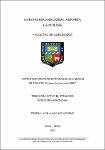Mostrar el registro sencillo del ítem
Características fenotípicas de 32 líneas S1 de tomate (Solanum lycopersicum Mill.)
| dc.contributor.advisor | Dueñas Dávila, Federico Alexis | |
| dc.contributor.author | Araujo Moreno, Teresa Lucila | |
| dc.date.accessioned | 2023-12-22T18:28:05Z | |
| dc.date.available | 2023-12-22T18:28:05Z | |
| dc.date.issued | 2023 | |
| dc.identifier.uri | https://hdl.handle.net/20.500.12996/6135 | |
| dc.description | Universidad Nacional Agraria La Molina. Facultad de Agronomía. Departamento Académico de Horticultura | es_PE |
| dc.description.abstract | El presente trabajo tuvo como finalidad evaluar las características fenotípicas y agronómicas de 32 líneas de tomate S1, procedentes del cruce entre el tomate comercial S. lycopersicum cv. Huascarán y S. lycopersicum var. ceraciforme. La fase experimental de esta investigación se realizó en el invernadero “Super Pepón” del programa de investigación en Hortalizas de la Universidad Nacional Agraria La Molina. A nivel de campo, se utilizó un arreglo de bloques completamente al azar (DBCA) con 32 tratamientos (líneas de tomate S1) y 5 repeticiones. Se evaluaron un total de 17 variables cualitativas y 12 variables cuantitativas, utilizando los descriptores de tomate del Instituto Internacional de Recursos Fitogenéticos (IPGRI). Los datos de las variables cuantitativas fueron sometidos a análisis de varianza (paramétrico), Kruskall Wallis (no paramétrico), análisis multivariado (análisis de componentes principales y agrupamiento jerárquico) y análisis de sendero. Por otro lado, se analizaron las variables cualitativas mediante una tabla de frecuencia. Se establecieron dos componentes principales que explicaron el 50.16% de la varianza total, la cual se explica principalmente por el peso, longitud y ancho de fruto, número de lóculos, número de días a la floración y maduración. Mediante el análisis de agrupamiento jerárquico se explicó que no existe una completa diferenciación dentro de cada familia y entre familias, sin embargo, la familia F-44 presentó las mejores características agronómicas tanto a nivel de planta como de fruto. Adicionalmente, el análisis de sendero reveló una fuerte relación directa entre el tamaño y peso de fruto, mientras que los sólidos solubles y la acidez titulable tuvieron un fuerte efecto causal en la calidad organoléptica del fruto. | es_PE |
| dc.description.abstract | The purpose of this study was to evaluate the phenotypic and agronomic characteristics of 32 S1 tomato lines from the cross between the commercial tomato S. lycopersicum cv. Huascarán and S. lycopersicum var. ceraciforme. The experimental phase of this research was carried out in the "Super Pepón" greenhouse of the Vegetable Research Program of the Universidad Nacional Agraria La Molina. At the field level, a completely randomized block arrangement (DBCA) was used with 32 treatments (S1 tomato lines) and 5 replications. A total of 17 qualitative and 12 quantitative variables were evaluated using the International Plant Genetic Resources Institute (IPGRI) tomato descriptors. Data from quantitative variables were subjected to analysis of variance (parametric), Kruskall Wallis (nonparametric), multivariate analysis (principal component analysis and hierarchical clustering) and path analysis. On the other hand, qualitative variables were analyzed using a frequency table. Two principal components were established that explained 50.16% of the total variance, which was mainly explained by weight, fruit length and width, number of locules, number of days to flowering and ripening. Hierarchical cluster analysis explained that there is no complete differentiation within and between families; however, the F-44 family presented the best agronomic characteristics both at the plant and fruit level. Additionally, path analysis revealed a strong direct relationship between fruit size and weight, while soluble solids and titratable acidity had a strong causal effect on fruit organoleptic quality. | es_PE |
| dc.format | application/pdf | es_PE |
| dc.language.iso | spa | es_PE |
| dc.publisher | Universidad Nacional Agraria La Molina | es_PE |
| dc.rights | info:eu-repo/semantics/openAccess | es_PE |
| dc.rights.uri | https://creativecommons.org/licenses/by-nc-nd/4.0/ | es_PE |
| dc.subject | Fenotipo | es_PE |
| dc.title | Características fenotípicas de 32 líneas S1 de tomate (Solanum lycopersicum Mill.) | es_PE |
| dc.type | info:eu-repo/semantics/bachelorThesis | es_PE |
| thesis.degree.discipline | Agronomía | es_PE |
| thesis.degree.grantor | Universidad Nacional Agraria La Molina. Facultad de Agronomía | es_PE |
| thesis.degree.name | Ingeniero Agrónomo | es_PE |
| dc.subject.ocde | https://purl.org/pe-repo/ocde/ford#4.01.05 | es_PE |
| renati.author.dni | 73642116 | es_PE |
| dc.publisher.country | PE | es_PE |
| dc.type.version | info:eu-repo/semantics/publishedVersion | es_PE |
| renati.advisor.orcid | https://orcid.org/0000-0002-6149-3334 | es_PE |
| renati.advisor.dni | 23860033 | es_PE |
| renati.type | https://purl.org/pe-repo/renati/type#tesis | es_PE |
| renati.level | https://purl.org/pe-repo/renati/level#tituloProfesional | es_PE |
| renati.discipline | 811036 | es_PE |
| renati.juror | Blas Sevillano, Raúl Humberto | |
| renati.juror | Moreno Llacza, Sarita Maruja | |
| renati.juror | Casas Díaz, Andrés Virgilio |
Ficheros en el ítem
Este ítem aparece en la(s) siguiente(s) colección(ones)
-
AGR-HO Tesis [244]





